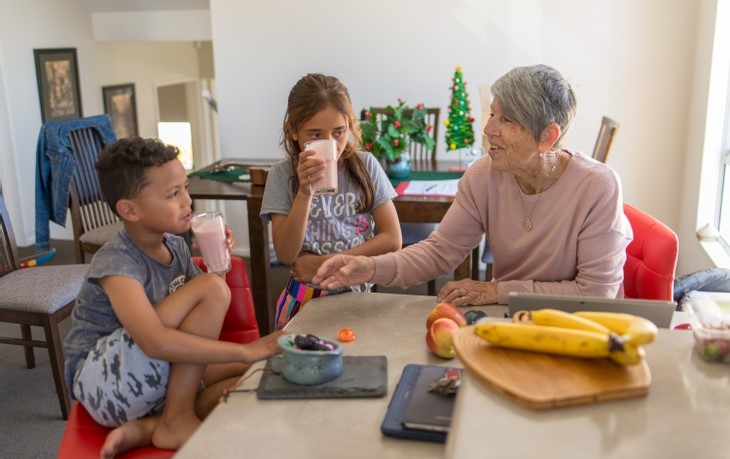Martin Bosley: How to make a yummy dish safely
Let former chef Martin Bosley take you through a delicious chicken and rice dish while learning a few handy kitchen safety tips along the way in the video above (recipe at bottom of page).
Famed foodie Martin Bosley has some of the best knife skills in the country. His knack for chopping has been honed by over 35 years of working in commercial kitchens.
But even Bosley has not always been able to avoid becoming one of the 70,000 New Zealanders who suffer a kitchen-based injury on average each year.
And it seems our kitchens are getting more dangerous. There were 73,730 active claims last year at a cost of over $74 million to help people recover – both figures were the highest for the last five years.

The dangers lurking in our kitchens
“Pretty much everything in a kitchen can hurt you or kill you,” Martin says of these alarming statistics.
“If it’s not hot, it’s sharp. And if it’s not sharp then it’s slippery. There’s a lot of action going on in there and the stress levels are always up. It’s frenetic and a lot of things can go wrong.”
Martin’s worst injuries came early on in a career in which he went on to excel in just about every foodie role you can imagine – including chef, restaurateur, fish-monger, columnist and author.
“I lost the top of a finger cutting bacon,” he recalls with a grimace. “I thought I was pretty cool with my head up looking around the kitchen – next thing I knew the top of my finger was lying on the chopping board.”
And it’s not just knives that have done serious damage to Bosley.
“I got some really bad burns when I was an apprentice – I tipped a bucket of hot fat all over my torso and thighs. I had to have many years of plastic surgery to recover.”
Kitchen injury risks on the rise
While Bosley has been more exposed to danger than most after spending so many years in commercial kitchens, budding master chefs at home are increasingly likely to hurt themselves.
Kitchen injury claims to ACC have risen nearly every year in recent times. There were 67,615 claims in 2017 but the average across the last three years has been well over 70,000.
The most common complaint by far last year was soft tissue injuries (33,666 claims) while lacerations and puncture wounds accounted for just over 19,000. Burns and fracture/dislocation come a distant third together with both averaging over 4,500 across the last five years.
The age group most likely to come a cropper in the kitchen is 65-plus, who suffered 20,571 injuries while cooking last year – at least four times more than any other age group.
That’s no surprise given the loss of strength and balance that comes with older age. But Bosley thinks a lack of concentration is usually to blame amongst the other age groups.
“It’s the simple mistakes that people make – it’s always a bit of carelessness or a moment’s inattention,” he says.
“For example, not paying attention when they’re cutting something or not using the right technique. Or slipping on a floor that’s greasy because there’s been a spill and no one’s cleaned it up.”

How to stay safe in your kitchen
Martin says the same rules that apply in commercial kitchens will also work well at home to keep Kiwis safe when they’re cooking their kai.
“The main ones are just to be aware of your surroundings and make sure of the simple things,” he says.
“A blunt knife is actually more dangerous so make sure your knives are sharp and that your surfaces are clean and tidy. Keep your chopping board clear and put a wet towel underneath it to stop it sliding all over the bench.
“And it’s very easy to make a mistake if you’re working in a messy and crowded area. So make sure you’re aware of the people in the kitchen with you and let them know you’re there. You don’t want to turn around with a knife in your hand if there’s someone standing right behind you.
“We say it’s all common sense but some of it is actually not that common. We don’t always think about these things so it’s easy for accidents to happen.”
Martin Bosley’s top five kitchen safety tips
- Keep your knives sharp – a blunt knife is actually more dangerous
- Put a wet towel under your chopping board to stop it sliding around
- Always use a 'claw technique' when chopping to avoid cutting your fingers
- Keep your bench space clean and always mop up spills immediately
- Turn pot/pan handles inwards when leaving something to simmer so you don’t knock it when walking past

Martin’s recipe for Arroz Con Pollo (Puerto Rican Rice with Chicken)
- 1 tbsp cooking oil
- 4 slices bacon
- ½ green chilli seeded and chopped (optional)
- 750g chicken nibbles (winglets) or bone-in thighs, skin on
- 1 onion, diced (about ½ cup)
- 2 garlic cloves, chopped
- 1 cup of long grain rice
- 1 can chick peas
- 1 can chopped tomatoes
- 1 tsp cumin powder
- 1 bunch of coriander, chopped (about ½ cup)
- Your favourite hot sauce to serve
Place a large frying pan or casserole dish over a medium heat and add the oil. Chop the bacon and add to the pan, cooking for 2-3 minutes then add the chilli. Add the chicken pieces and brown all over, about 4-5 minutes. Add the diced onion and garlic. Cook for about a minute, until the onion starts to turn golden brown.
Stir in the rice and cook for about a minute, stirring frequently. Drain the chick peas, measuring out the brine – you need to add 2 cups of liquid to the rice, so make up the difference with water or chicken stock. Add this to the rice along with the chick peas and the chopped tomatoes. Bring to a boil then turn the heat right down to a gentle simmer.
Add the cumin and coriander. Taste for salt – if you have added the chili you won’t need to add any pepper. Cook for 25 minutes and serve with hot sauce.
Add peas, spinach, olives, capers or roasted peppers if you wish.




